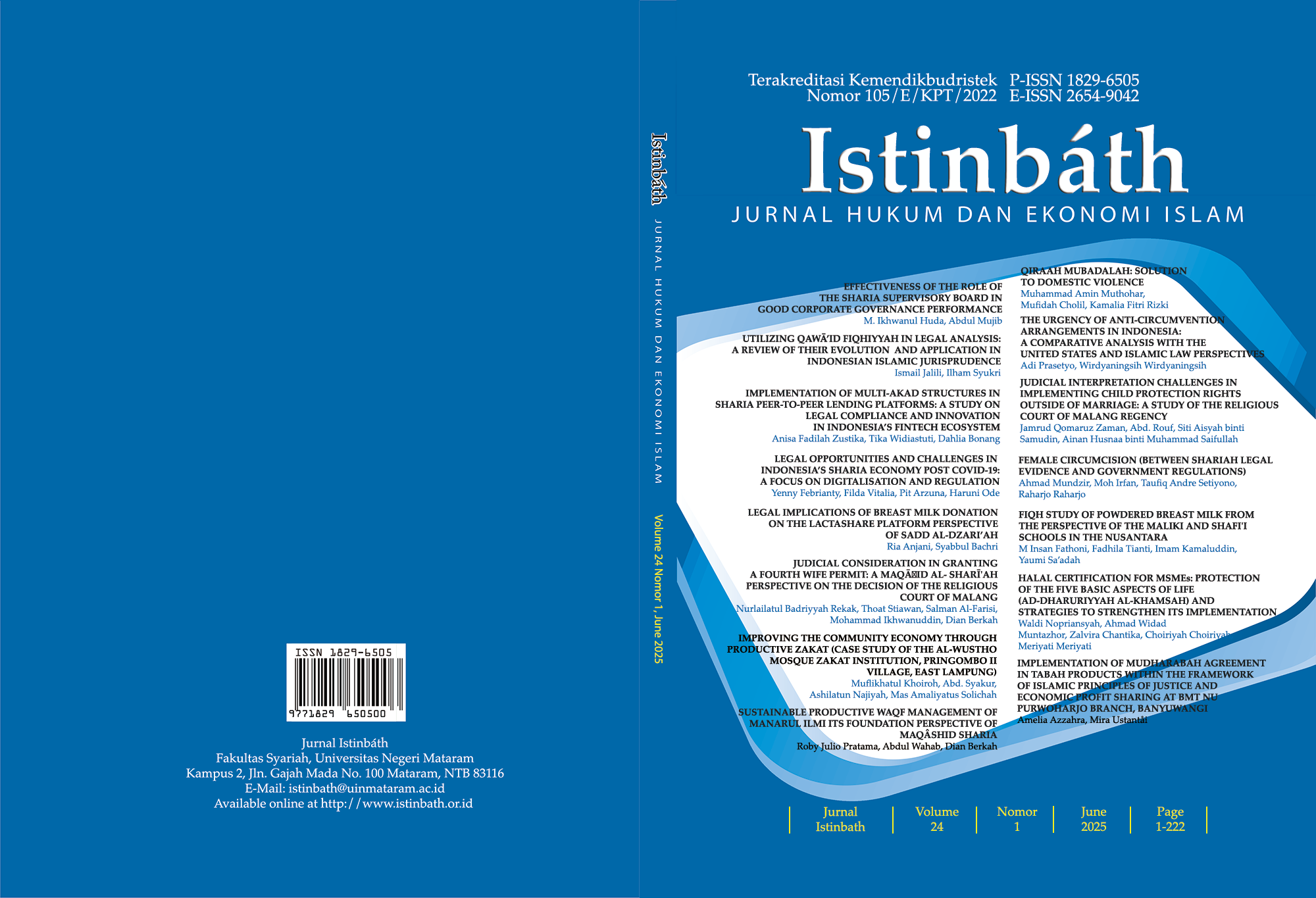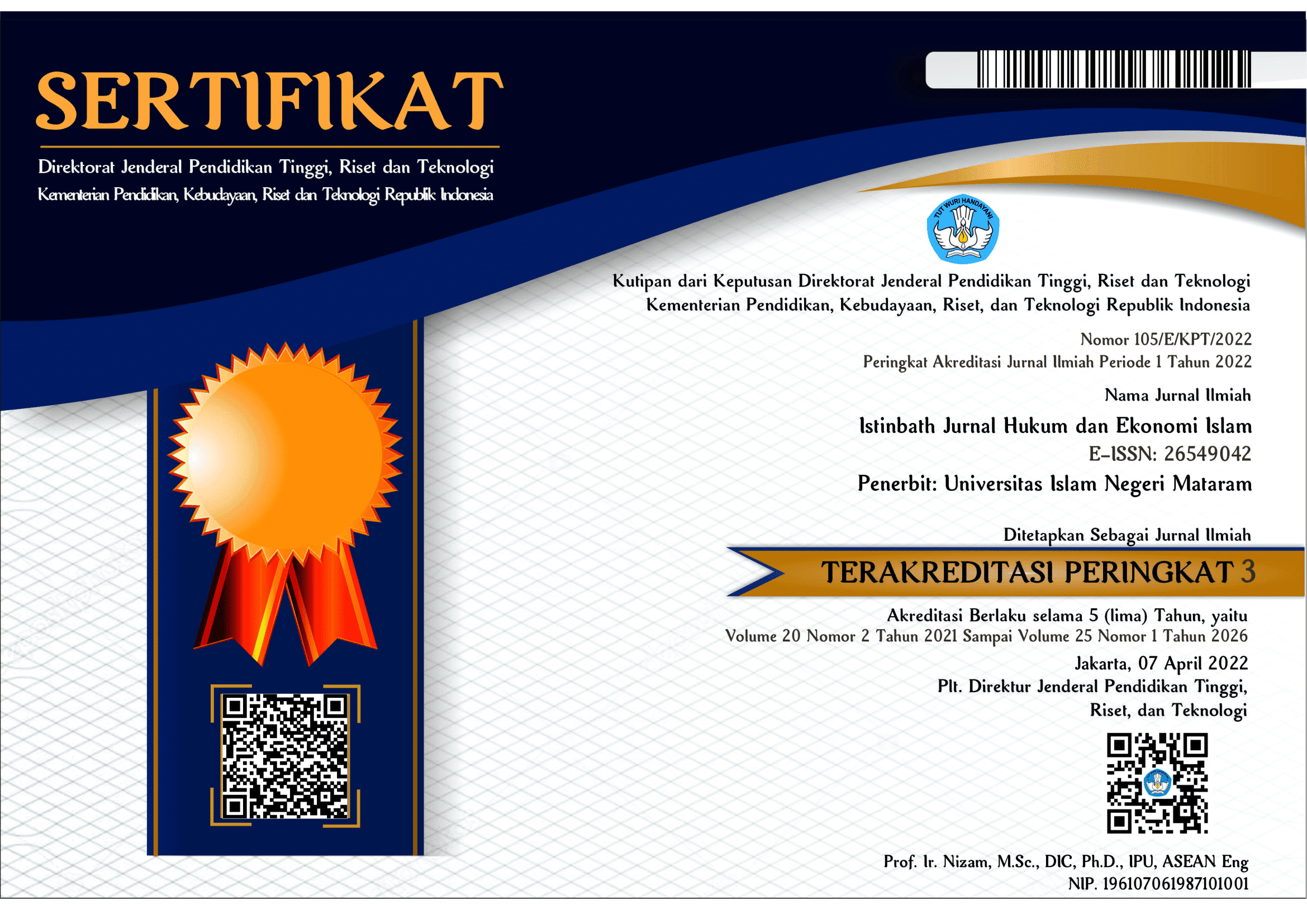IMPLEMENTATION OF MUDHARABAH AGREEMENT IN TABAH PRODUCTS WITHIN THE FRAMEWORK OF ISLAMIC PRINCIPLES OF JUSTICE AND ECONOMIC PROFIT SHARING AT BMT NU PURWOHARJO BRANCH, BANYUWANGI
DOI:
https://doi.org/10.20414/ijhi.v24i1.950Keywords:
Mudharabah Agreement, Mudharabah Savings, Islamic Economic PerspectiveAbstract
This research aims to comprehensively analyze the implementation of the mudharabah contract in TABAH savings products at BMT NU Purwoharjo Branch, focusing on its conformity with Islamic economic principles. The novelty of this study lies in its contextual exploration of the Purwoharjo Branch, which has unique socio-economic characteristics, and in offering an operational assessment of mudharabah practices that have not been covered in previous research. The study also critically examines how operational standards reflect Islamic values such as justice, amanah (trust), and maslahah (public benefit). This research uses a descriptive qualitative method with a case study approach. Data were collected through in-depth interviews with BMT managers and customers, direct observations of daily operations, and analysis of documents such as SOPs, financial reports, and contract agreements. Data validation was ensured through source, method, and theoretical triangulation, and analysis was conducted using Miles and Huberman's interactive model involving data reduction, categorization, and conclusion drawing. The findings show that implementing the mudharabah contract at BMT NU Purwoharjo Branch aligns with key Islamic economic principles such as transparency, fairness in profit-sharing, and trust-based (amanah) fund management. The profit-sharing ratio is determined based on mutual agreement, reflecting Islamic law's principle of willingness (taradhi). However, a gap remains in customer understanding of mudharabah mechanisms, particularly regarding the concept of risk-sharing and the customer's role as shahibul mal, indicating the need for strengthened financial literacy. On the other hand, BMT's fund allocation supports halal and productive micro-business sectors, aligning with the principle of maslahah and contributing to local economic empowerment. Risk mitigation is addressed through stringent partner selection and continuous monitoring. This study provides practical insights into operationalizing Islamic contractual values in microfinance institutions and expands the growing literature on context-based mudharabah implementation.
References
Abdussamad, H. Z., & Sik, M. S. (2021). Metode Penelitian Kualitatif. Cv. Syakir Media Press.
Al-Qaradhawi, Y. (2022). Norma Dan Etika Ekonomi Islam. Gema Insani.
Alamsyah, B., Aisya, K., & Susilawati, C. (2024). Mudharabah: Sharia-Based Financing Mechanism For Sustainable Economic Development. International Journal Of Nuh: Law, Policy, And Human Behavior, 1(1), 32–50. https://doi.org/10.63005/6717c880
Aziz, A. A., & Elbadriati, B. (2019). Peluang Dan Tantangan Literasi Pasar Modal Syariah Di Mataram. Istinbath, 18(1). https://doi.org/10.20414/ijhi.v18i1.148
Bakry, M., & Masse, R. A. (2020). Diskursus Prinsip Syariah Dalam Akad Transaksi Murabahah Pada Perbankan Syariah Di Makassar. Jurnal Istinbat, 19(1). https://doi.org/10.20414/ijhi.v19i1.202
Djamil, F. (2023). Hukum Ekonomi Islam: Sejarah, Teori, Dan Konsep. Sinar Grafika.
Djamil, N. (2023). Akuntansi Terintegrasi Islam: Alternatif Model Dalam Penyusunan Laporan Keuangan: Islamic Integrated Accounting: Alternative Models In Preparing Financial Statements. Jaamter: Jurnal Audit Akuntansi Manajemen Terintegrasi, 1(1), 1–10. https://doi.org/10.5281/zenodo.8384951
Febriyanti, F., Jannah, R., Wulandari, Z., Hastutik, H., & Megawati, N. (2023). Strategi Pemasaran Produk Tabungan Mudharabah Di Bmt Nu Dan Implementasinya Berbasis Digital Di Cabang Tlanakan Pamekasan. Prospeks: Prosiding Pengabdian Ekonomi Dan Keuangan Syariah, 1(2), 198–204. https://journal.al-khairat.ac.id/index.php/prospek/article/view/47
Fuadi, F. (2021). Bank Dan Lembaga Keuangan Non Bank (Teori Dan Aplikasi). Penerbit Adab.
Kharismawan, O. (2021). Implementasi Strategi Pemasaran Yang Efektif Dalam Meningkatkan Jumlah Nasabah Produk Tabungan Mudharabah Pada Baitul Maal Wat Tamwil Pahlawan Tulungagung.
Matnin, Nailatul Maghfiroh, Nabilatus Soleha, 4nasihah. (2022). Implementasi Akad Mudhorobah Mutlaqah. 1(2), 115–120.
Matnin, M., Anggraini, D., Fatimah, F., Hasanah, H., Zahroh, N., & Hasanah, U. (2023). Model Pelayanan Tabungan Anggota Kspps Bmt Nu Cabang Larangan. Investi: Jurnal Investasi Islam, 4(1), 503–513. https://doi.org/10.32806/ivi.v4i1.120
Muhammad Kurniawan, S. E., & Sy, M. E. (2021). Bank Dan Lembaga Keuangan Syariah (Teori Dan Aplikasi). Penerbit Adab.
Putra, P. A. A., Imaniyati, N. S., & Nurhasanah, N. (2021). Al-Murâbahah Li Al-Âmir Bi Al-Syirâ: Studi Pemikiran Yûsuf Alqaradhâwî Dan Relevansinya Dengan Fatwa Dsn-Mui. Istinbath, 20(2), 262–295. https://doi.org/10.20414/ijhi.v20i2.387
Putri, B., & Winario, M. (2024). Implementasi Akad Salam Dalam Pembiayaan Perbankan Syariah Di Indonesia. Multidisciplinary Journal Of Religion And Social Sciences, 1(1), 1–9. https://doi.org/10.69693/mjrs.v1i1.43
Rahman, T. (2021). Buku Ajar Fiqih Muamalah Kontemporer (Vol. 1). Academia Publication.
Ramdhan, M. (2021). Metode Penelitian. Cipta Media Nusantara.
Rosyid, A., Jannah, N., Azizah, W. N., & Syarifah, W. (2023). Implementasi Sistem Jemput Bola Pada Produk Tabungan Mudharabah Di Kspps Bmt Nu Jawa Timur Cabang Kota Sumenep. Prosiding, 1(1), 89–96. https://doi.org/10.32806/pps.v1i1.261
Sa’diyah, M. (2019). Fiqih Muamalah Ii: Teori Dan Praktik. Unisnu Press.
Zaidi, M. (2024). Linguistic Clarity In Mudharabah Contracts: Ensuring Transparency And Fairness In Indonesian Islamic Financial Institutions. Journal Of Languages And Language Teaching, 12(2), 708–722. https://doi.org/10.33394/jollt.v12i2.9658
Zaki, M. (2022). Implementasi Akad Mu Ḍ H Ā Rabah Mu Ṭ Laqah Dalam Produk Tabah Terhadap Minat Nasabah Di Kspps Bmt Nu Cabang Pragaan. 5(1), 107–124. http://dx.doi.org/10.28944/masyrif.v5i1.1797
Downloads
Published
How to Cite
Issue
Section
License
Copyright (c) 2025 Amelia Azzahra, Mira Ustanti

This work is licensed under a Creative Commons Attribution-ShareAlike 4.0 International License.





